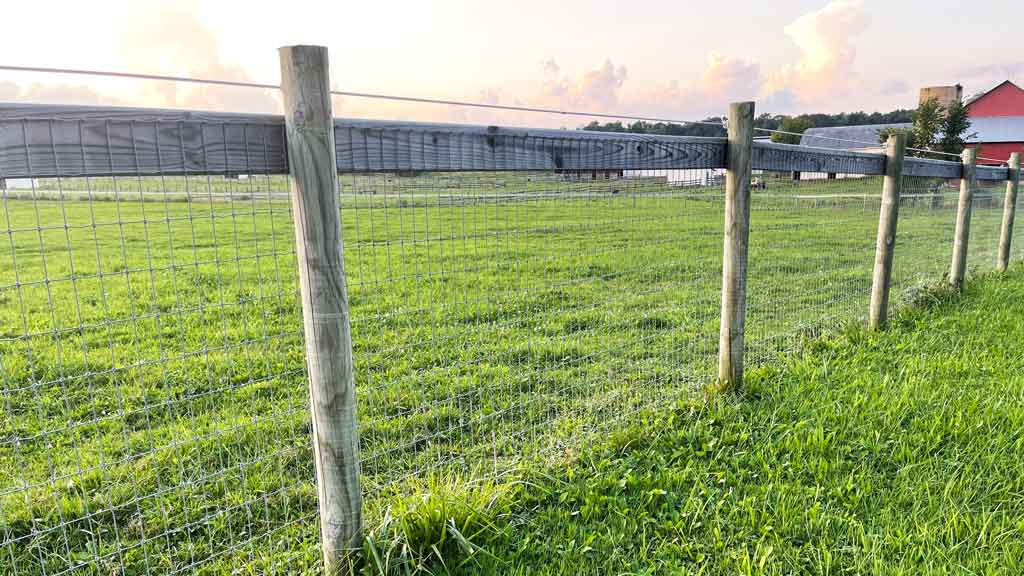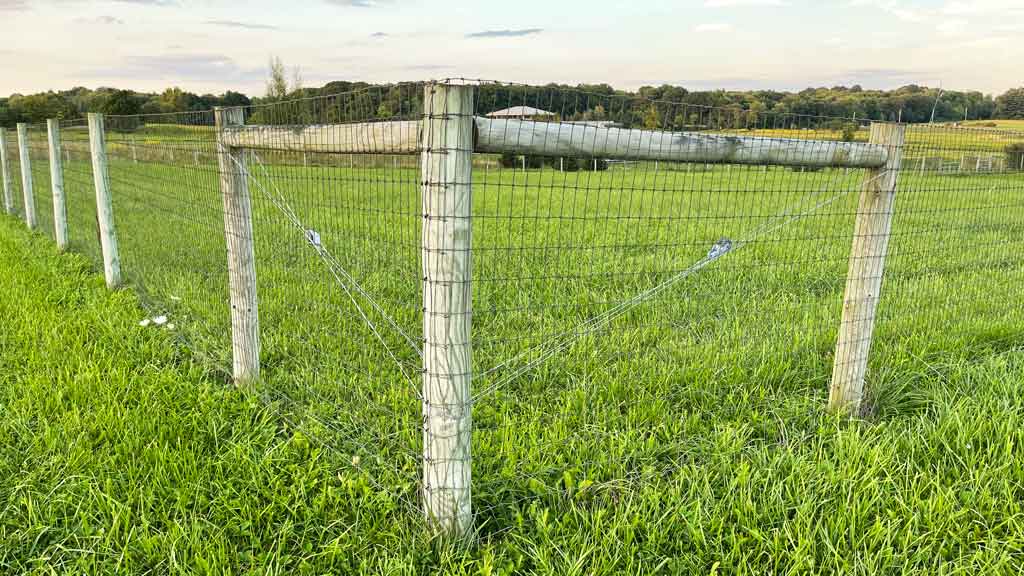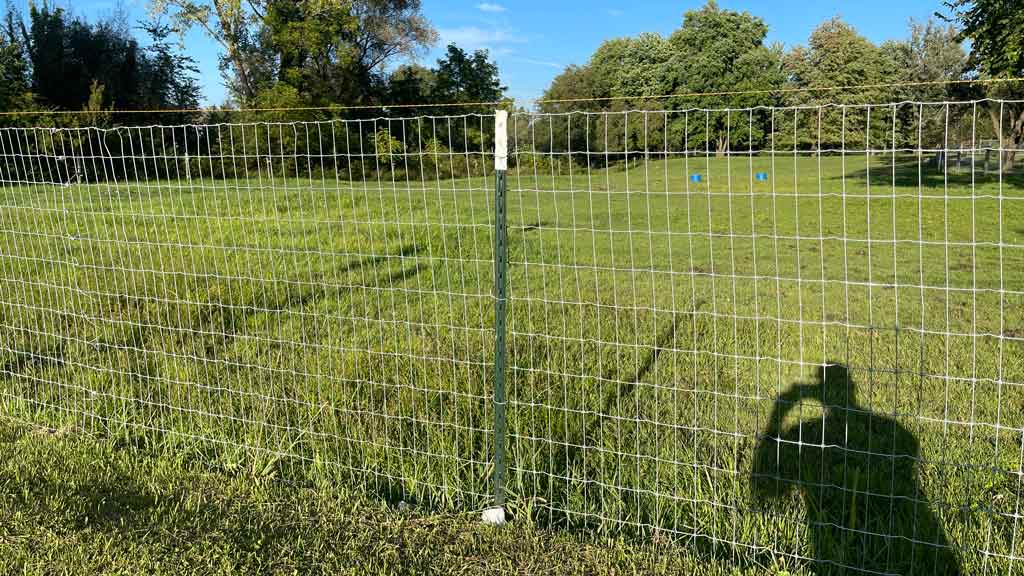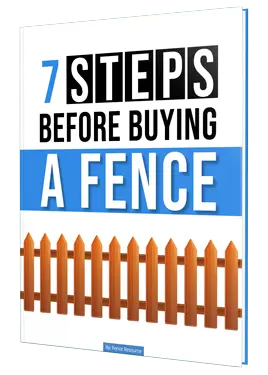
No climb fence is a type of woven wire horse fence. Vertical and horizontal wires intersect to form 2″x4″ rectangular holes.
A special wire knot ties the intersecting strands of weaving wire together that creates a smooth connection. As a result, protecting horse hides.
The size of the hole makes it difficult for hooves of horses and livestock to pass through. Therefore, creating a non climb horse fence.
As a result, making no climb fence a very popular horse fence for farms and ranches. And let’s face it…….don’t we all want our horse to be protected by the best equestrian fence available?
Advantages of No Climb Fencing
When installing fencing, choosing the right one for the job is a must. When done right, you shouldn’t have to think about it ever again once installed.
No climb fence has some noteworthy advantages over other types of wire fence. Safety, affordability, ease of installation and durability are just a few worth mentioning.
No Climb Fence is Safe for Horses
As we already mentioned, the smaller grid pattern of the vertical and horizontal wires are held together by a special wire knot. Making it safer than other woven wire fences. This is the number one reason horse owners, farmers and ranchers choose no climb fence.
Preventing accidents is important to everyone. Nobody likes to see an injured animal. However, keeping animals contained in the fencing and safe is just one advantage.
It also keeps other animals from entering the fencing as well. Hogs and other varmints love to root around and burrow in horse pastures.
Installing a no climb fence helps keeps unwanted animals from destroying pastures and fields. It also helps in deterring predators.

No Climb Fence is Affordable
When compared to other types of fencing, woven wire fence is affordable. It is much cheaper than installing wood or vinyl fence.
Horses need a lot of room to run. That translates into lots of horse fence! Therefore, saving money where possible, without sacrificing performance is crucial. This is very important to farm managers.
Other than high tensile wire and barbed wire fences, no climb fence is more affordable than other types of horse fence.
It Doesn’t Require Maintenance or Upkeep
Once you install a no climb fence, forget about it! The fencing is virtually maintenance free. The strands of wire come galvanized to prevent rust and fight the elements.
As a result, providing years if not decades of maintenance free performance. The posts will rot out before the wire mesh will.
Furthermore, there are types of no climb fence with heavier galvanization for maximum life expectancy.
No Climb Fence is Durable – Lasting Decades
The top and bottom stands of wire are 10 gauge diameter. The rest of the fill wire is 12-1/2 gauge diameter. The combination of these two result in a strong fencing built to last.
The special knot used to hold the strands together also adds strength. Impacts from animals won’t damage the wire mesh. Even fallen tree branches won’t be enough to damage it beyond use.
The rigid design of no climb horse fence wire allows it to have strength while at the same time being flexible enough to flow over uneven or hilly terrain.
No Climb Fence Options

There isn’t a one size fits all solution when dealing with horse fence. What works for one farm or ranch may not be suitable for the next. As a result, manufactures offer a variety of options.
Height, color, class of galvanization, and the size of the fence roll are all available options when buying no climb fence.
Height Options of Non Climb Fence
What you are trying to contain will determine the height of the field fence needed. The good thing is you have options!
No climb fence comes in heights of 36″, 48″, 60″ and 72″ tall. Most horse fences are 48″ to 60″ tall.
Fence Roll Sizes
Rolls of fencing come in different sizes when concerning the total amount of footage each roll contains.
Woven wire fence is heavy. Because no climb fence has twice the amount of weaving wire as other types of woven wire fence, the rolls have to be smaller in order to manage them. Standard length are 100′ and 200′ long.
When installing long lines of non climb horse fence, the fewer splices the better. Therefore, using the larger roll will result in less splices. Which makes for stronger fencing.
However, depending on the layout of the horse fence, using smaller rolls may be more efficient.
Galvanized Rating
The thickness of the galvanized coating determines the class. Class 1 and Class 2 are available. Use class 1 galvanized fencing for most applications.
Class 2 no climb wire has more galvanization. As a result, it used in areas that are more likely to corrode. Fencing near roads are a perfect place to use the heavier Class 2 coating.
Although, if maximum life expectancy is the goal, use Class 2 galvanized fencing for all fence lines.
Color Options of No Climb Horse Fence
Galvanization is silver. As result, fencing that is galvanized is also silver in color. The bright shiny silver will oxidize over time and turn a dull gray color.
However, some farm and ranch owners can’t stand the site of silver looking horse fence. They think it looks commercialized. Therefore, some manufactures offer no climb fence in black.
The black fence is softer to the eye and blends in better than galvanized. However, the fencing is still galvanized first for protection. Then painted the black color.
How to Install No Climb Horse Fence
Installing a non climb horse fence is easy. As result, most farmers and ranchers do it themselves. There are only 2 components to installing the fencing.
The first of course is the horse fence itself. The second are the posts. There are two categories of fence posts. End, corner and pull posts is the first. The second are the intermediate posts, called line posts.

End, Corner and Pull Posts for Horse Fence
These are the posts that do all the work. They are the foundation of the fence. As a result, you should not skimp when it comes to end, corner or pull posts.
Most installs will use wood posts for these. However, galvanized steel is becoming more popular due to their strength and longer life expectancy.
Set the posts deep. A a minimum 36″ deep. However 48″ is better. These posts hold all the weight of the stretch of the fencing. Keeping the horizontal wires tightly stretched. Therefore overkilling them is impossible.
The first line post should be of the same material. Use a horizontal brace and wire truss tensioner to connect the first and second posts together. This adds extra strength and support.
Types of Line Posts and Spacing for Non Climb Fence

Traditionally woven wire horse fence has wooden, metal T-posts or star picket fence posts used for line posts. The spacing of the line posts adds to, or takes away from the strength of the fence.
Normal post spacings for horse and equestrian fence are 8′, 10′ and 12′ on center.
Wooden line posts require more labor to install. Hydraulic post drivers attached to tractors or skid steers drive the posts into the ground. However, some soils conditions may require augering a pilot hole first to set wood posts.
Wood posts are safer for horses that like to scratch themselves against the fence. However, wood posts break and rot, eventually causing maintenance.
Metal T-posts or star pickets install much easier. Many times driven by hand with a post driver. However, they can have sharp edges as a result of the driver smashing the top of the post.
Potentially leading to injury for horses. Driving the posts just below the height of the fencing helps. Adding one strand of barbed wire above the fencing also prevents horses from leaning on it.

Stretching No Climb Fence
Stretching any type of woven wire field fence is pretty easy. No climb fence is no different. First, attach one side to an end or corner post.
Next, roll the wire out along the sides of the line posts to the ending point. A this point, stand the wire mesh up and lean it against the line posts.
Insert a stretch bar into the loose end of the fence approximately 8′ – 10′ from the end. Come-a-longs attached to the end post, and hook to the stretch bar.
Pull the mesh tight by cranking the come-a-longs. Bouncing the wire in the middle of the line will allow it to stretch evenly. Once the fencing is stretched tight, attach the loose end to the end post and relax the come-a-long tension.
Horseshoe nails or fencing staples attach the fence to wood posts. Use a fence tie or clip to attach it to metal T-posts.
Final Thoughts on No Climb Fence
No climb fence is a safe an cost effective solution for a non climb horse fence. One that requires little to no maintenance and will last for decades.
Great for covering large pastures. The fencing is easy to install and flows over uneven or hilly terrain well.
A popular style of horse fence that will provide you will a peace of mind that your horses are safe and secure.

